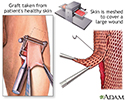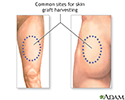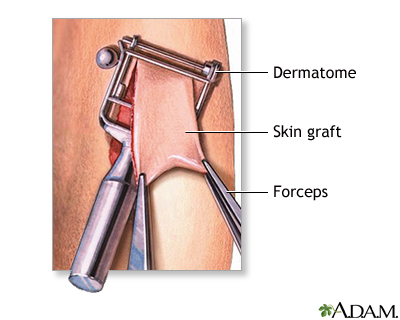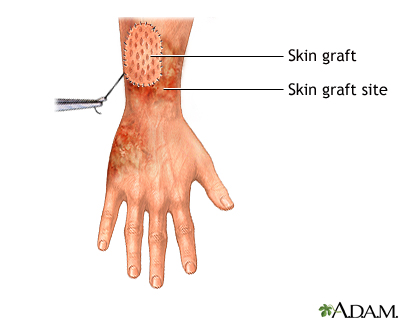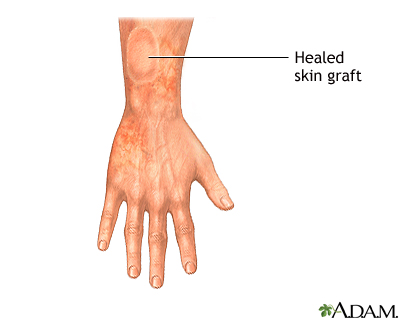Skin graft
Skin transplant; Skin autografting; FTSG; STSG; Split thickness skin graft; Full thickness skin graft
A skin graft is a patch of skin that is removed by surgery from one area of the body and transplanted, or attached, to another area.
Description
This surgery is usually done while you are under general anesthesia. That means you will be asleep and pain-free.
Healthy skin is taken from a place on your body called the donor site. Most people who are having a skin graft have a split-thickness skin graft. This takes the two top layers of skin from the donor site (the epidermis) and the layer under the epidermis (the dermis).
The donor site can be any area of the body. Most times, it is an area that is hidden by clothes, such as the buttock or inner thigh.
The graft is carefully spread on the bare area where it is being transplanted. It is held in place either by gentle pressure from a well-padded dressing that covers it, or by staples or a few small stitches. The donor-site area is covered with a sterile dressing for 3 to 5 days.
People with deeper tissue loss may need a full-thickness skin graft. This requires the entire thickness of skin from the donor site, not just the top two layers.
A full-thickness skin graft is a more complicated procedure. Common donor sites for full-thickness skin grafts include the chest wall, neck, back, or abdominal wall.
Why the Procedure Is Performed
Skin grafts may be recommended for:
- Areas where there has been infection that caused a large amount of skin loss
- Burns
- Cosmetic reasons or reconstructive surgeries where there has been skin damage or skin loss
- Skin cancer surgery
- Surgeries that need skin grafts to heal
- Venous ulcers, pressure ulcers, or diabetic ulcers that do not heal
- Very large wounds
- A wound that the surgeon has not been able to close properly
Full-thickness grafts are done when a lot of tissue is lost. This can happen with open fractures of the lower leg, or after severe infections.
Risks
Risks for anesthesia and surgery in general are:
- Allergic reactions to medicines
- Problems with breathing
- Bleeding, blood clots, or infection
Risks for this surgery are:
- Bleeding
- Chronic pain (rarely)
- Infection
- Loss of grafted skin (the graft not healing, or the graft healing slowly)
- Reduced or lost skin sensation, or increased sensitivity
- Scarring
- Skin discoloration
- Uneven skin surface
Before the Procedure
Tell your surgeon or nurse:
- What medicines you are taking, even drugs or herbs you bought without a prescription.
- If you have been drinking a lot of alcohol.
During the days before surgery:
- You may be asked to stop taking medicines that make it hard for your blood to clot. These include aspirin, ibuprofen, warfarin (Coumadin), and others.
- Ask your surgeon which drugs you should still take on the day of your surgery.
- If you smoke, try to stop. Smoking increases your chance of problems such as slow healing. Ask your health care provider for help quitting.
On the day of the surgery:
- Follow instructions about when to stop eating and drinking.
- Take the drugs your surgeon told you to take with a small sip of water.
After the Procedure
You should recover quickly after split-thickness skin grafting. Full-thickness grafts need a longer recovery time. If you received this kind of graft, you may need to stay in the hospital for recovery.
After you are discharged from the hospital, follow instructions on how to care for your skin graft, including:
- Wearing a dressing for 1 to 2 weeks. Ask your provider how you should care for the dressing, such as protecting it from getting wet.
- Protecting the graft from trauma for 3 to 4 weeks. This includes avoiding being hit or doing any exercise that might injure or dislodge the graft.
- Getting physical therapy, if your surgeon recommends it.
Outlook (Prognosis)
Most skin grafts are successful, but some do not heal well. You may need a second graft.
References
Padilla PL, Khoo KH, Ho T, Cole EL, Sirvent RZ, Phillips LG. Plastic surgery. In: Townsend CM Jr, Beauchamp RD, Evers BM, Mattox KL, eds. Sabiston Textbook of Surgery. 21st ed. St Louis, MO: Elsevier; 2022:chap 69.
Ratner D, Nayyar PM. Grafts, In: Bolognia JL, Schaffer JV, Cerroni L, eds. Dermatology. 4th ed. Philadelphia, PA: Elsevier; 2018:chap 148.
Scherer-Pietramaggiori SS, Pietramaggiori G, Orgill DP. Skin graft. In: Gurtner GC, Neligan PC, eds. Plastic Surgery, Volume 1: Principles. 4th ed. Philadelphia, PA: Elsevier; 2018:chap 15.
Review Date: 3/10/2021
Reviewed By: Tang Ho, MD, Associate Professor, Division of Facial Plastic and Reconstructive Surgery, Department of Otolaryngology – Head and Neck Surgery, The University of Texas Medical School at Houston, Houston, TX. Also reviewed by David Zieve, MD, MHA, Medical Director, Brenda Conaway, Editorial Director, and the A.D.A.M. Editorial team.





